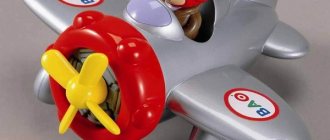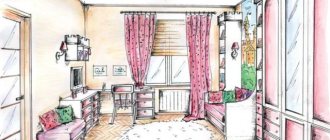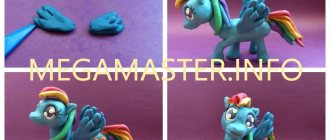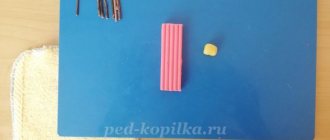Summary of a modeling lesson in the preparatory group “Three Bears”
Svetlana Igosheva
Summary of a modeling lesson in the “Three Bears” preparatory group
Summary of a modeling lesson in the preparatory group
Topic: "Three Bears "
.
Goal: to arouse interest in fairy-tale images, to consolidate the ability to convey them expressively in sculpting . Encourage children to convey in modeling the images of Mikhail Ivanovich, Nastasya Petrovna and the little bear . Organizing time.
Educator: One, two, three, get into a fairy tale.
Teacher and children: One, two, three, get into a fairy tale.
There are pictures of three bears .
Educator: Guys, today I will be a magic fairy. Guys, tell me what fairy tale we got into? Who knows?
Children: (suggested answers)
: Three
Bears .
Educator: That's right, these are three bears . I wonder what happened in this fairy tale, now we’ll find out.
Educator: Three bears returned after a walk and noticed that their chair at Mishutka’s was broken. Mishutka was very upset that he was left without a chair. How can we help Mishutka?
Children voice their answers.
Educator: Guys, I suggest you mold the heroes of the fairy tale “Three Bears ”
.
Educator: Guys, look at our board. There are cards on it. Grab some plasticine and let's get started.
Educator: Praises the children.
Educator: Well done guys, I really liked the way you completed the task. Pasha, who did you sculpt? Vika, what kind of bear did you get ?
Children voice their answers.
Summary of the integrated lesson “On a visit to the fairy tale “The Three Bears”” Topic: “On a visit to the fairy tale “The Three Bears””. Priority direction: speech development, integrating artistic and aesthetic development.
Summary of organized educational activities on sculpting in the middle group “Three Bears” Goal: To develop the ability to sculpt a figurine of a bear. Objectives: 1. Strengthen the ability to divide a lump of plasticine into parts, use familiar methods.
Notes on speech development with elements of dramatization in preparation for the compensatory group “Three Bears” GOAL: Formation of the ability to conduct a basic dramatization of an already familiar fairy tale, accurately reproducing the characters’ lines. Objectives: 1. Teach.
Summary of the lesson on FEMP “Three Bears Visiting Children” Purpose: To teach to take into account the size of objects in the game, to evoke a positive emotional attitude towards game actions that require taking into account the size.
Lesson summary for the theatrical activity “Three Bears” Goal: to develop children’s interest in fiction through fairy tales; develop the ability to expressively convey intonation.
Lesson notes on theatrical activities. Staging of the fairy tale “The Three Bears” (middle preschool age) Educational field: Artistic and aesthetic Topic: Fairy tale “Masha and the Three Bears” Age group: middle group Purpose: staging.
Lesson summary "Three Bears" on speech development with elements of sensory education Lesson summary Visiting the fairy tale "Three Bears" Goal: development of children's speech through theatrical activities and familiarization with the oral language.
Summary of the lesson “Three Bears” on FEMP for children of the senior group Program content: Introduce the quantitative composition of the number 3 from units; with the number 10. Strengthen ideas about the parts of the day; Exercise.
Summary of the lesson “Journey to the fairy tale Three Bears” using puppet therapy Lesson “Journey to the fairy tale Three Bears” using puppet therapy
Our life is essentially a puppet show. Just need it.
Source
Summary of GCD for modeling in the preparatory group “Furniture for a doll’s house”
Ekaterina Shchirova
Summary of GCD for modeling in the preparatory group “Furniture for a doll’s house”
Summary of GCD for modeling in the preparatory group “Furniture for a doll’s house”
Form of organization:
Group.
Type of lesson:
Artistic and aesthetic (modeling).
Target:
Develop plasticine modeling skills.
Tasks:
1. Continue teaching children to sculpt doll furniture, create objects of different sizes and colors; develop fine motor skills, interest in productive activities, and creative imagination.
2. Learn to select relative and qualitative adjectives; activate the names of pieces of furniture in children’s speech; consolidate the ability to identify a preposition audibly and correctly correlate it with an action.
3. Teach children to negotiate with each other and adequately evaluate their work.
Material:
plasticine, stacks, plates for modeling, napkins, dollhouse, photographs of furniture.
Progress of the lesson
Educator:
We're in trouble; we've lost our doll furniture. Guys, let's make new furniture for our dollhouses. Are you willing to help?
Children:
Yes.
Educator
: Pay attention to the house. It is partially filled with furniture, some rooms are empty.
Educator:
What kind of room do you think is on the second floor?
Children:
Bedroom.
Educator:
- How did you guess?
Children:
There is a bed there.
Educator:
What rooms can be located on the ground floor? Do you know what rooms (living room, kitchen) are already written here?
Educator:
List the pieces of furniture that can be in the living room? (sofa, armchair, coffee table)
- And in the kitchen? (table, stool)
Educator:
- Guys, but don’t forget that the house is a toy and the furniture in it is also a toy. Think and tell me, what can we quickly make doll furniture from? (made of plasticine).
But before we start working, let’s set up our fingers so that they work hard so that the furniture is durable, strong, beautiful, and neat.
Let's play.
Physical education minute:
This is a chair - they sit on it (the left palm in a fist is pressed against the right, fingers extended upward).
This is a table - people sit at it (the left hand is in a fist, the right open palm lies on top)
Here is a bed - they are lying on it (arms bent at the elbows in front of the chest, lying one on top of the other)
We put things away in the closet (imitation of folding things)
And we all work hard (the fingers of both hands walk on the knees)
Educator:
Guys, today you are working in threes - how is that? Look at each other and decide who will work with whom (in a whisper)
— The first three sculpt pieces of furniture for the kitchen.
- The second one is for the living room.
— Go to your workplaces.
- Now you must agree on what piece of furniture each of you will sculpt.
- Look at the pictures, pay attention to the characteristic features of the piece of furniture, what parts the object consists of. Now close your eyes and imagine this object.
Make the furniture not very large, and the sausage legs not too thin, otherwise they will not hold the seat and tabletop.
Bottom line
Educator:
Guys, what did we do today (Children's answers).
Today we worked hard and reviewed everything we learned about furniture.
Analysis of works
Look how beautiful the furniture turned out. I really liked all your works. It’s clear that you all tried very hard, you’re all great.
Abstract of the GCD for plot modeling “Three Bears” (senior group)
Vlasenko Elena
Abstract of the GCD for plot modeling “Three Bears” (senior group)
Modeling plot
“Three
Bears ” (
senior group ) Purpose: To create conditions for the manifestation of creative skills in children.
— Introduce children to sculpting a bear in a constructive way .
— To develop the aesthetic taste of children when decorating a bear .
- Cultivate interest in artistic work.
V.: Guys, I invite everyone to the theater. Come on in. Sit down please. Do you hear someone crying? (the teacher speaks for the heroes)
.
-Who ate from my cup and drank it all? (say in the voice of Mikhailo Potapych)
—Who was sitting on my chair and moved it? (say in Nastasya Petrovna’s voice)
.
Who slept in my bed and rumpled it? (say in Mishutka’s voice)
.
V.: Guys, did you recognize the fairy tale? (Yes)
.
What is it called? (three
Bears ) .
Do you remember the names of the fairy tale heroes? (Mikhailo Potapych, Nastasya Petrovna, Mishutka, Mashenka)
. That's right guys.
Q: What do the heroes of the fairy tale look like? What did they do in the fairy tale? (children's answers)
.
(detailed examination of bears , highlighting distinctive features).
V.: Guys, would you like to become wizards and bring a fairy tale to life? (Yes)
.
How can we do this? (blind)
. Let's blind the heroes and the fairy tale will come to life.
(ask the children who they want to make)
.
V.: Masha, who will you sculpt? And you Sasha? And you Igor?
V.: Guys, do you know how to make a bear ? (children's options)
V.: We take a piece of plasticine in our hands. If we want to make a daddy bear , what piece of plasticine should we take? (big, all)
.
for a mother bear ? (slightly smaller)
.
How much plasticine do you need for a bear? (smaller, a little more than half of the original piece)
V.: Knead in your hands until soft. From the piece of plasticine chosen for the hero we pinch off 3 unequal parts. One is larger, and two are approximately the same. A ball is rolled out of the large part, then we roll this ball in our palms, this is the shape we get. What is it called? (cone, carrot)
.
From the other part we roll a ball in our palms - this is the head of a bear . We said that what kind of face does a bear ? (slightly elongated)
.
How can you give this shape to a bear's ? (pull it out a little with your fingers)
.
The head is attached to the body. Divide the remaining plasticine into two parts. One is larger, the other is smaller. We divide the smaller piece in half - these are the ears. We roll each piece of plasticine for the ears into a ball, then flatten it and attach it to the head. We roll out the last piece of plasticine into a sausage shape and divide it into 4 equal parts - these are bear . We press the paws to the body. It turned out to be a bear . What kind of clothes can Nastasya Petrovna make? And Mikhail Potapych? And the bear (children's suggestions)
.
V.: Guys, you can start reviving the fairy tale. Whoever needs my help, I will be there. (player observes the process, helps children correct mistakes)
.
V.: Show the guys your work. Did you manage to bring the fairy tale to life? (happened)
. Let us now organize a mini-exhibition and choose the most neat, beautiful work.
Three bears were walking home .
Papa bear was big
Mom is a little shorter,
And my son is just a little boy.
He was the smallest and walked around with rattles.
Methodological techniques: surprise moment, problem situation, inclusion of motivation, associative pantomime, artistic expression, modeling in a given key , problematic questions, encouragement, bringing the object closer to children, using a story plan, generalizing story
GCD summary for FEMP in the senior group “Journey to the fairy tale “Three Bears”” GED summary for the senior group “Bee” FEMP on the topic: “Journey to the fairy tale “Three Bears” Age group: senior GCD topic: Travel.
Summary of an integrated lesson in a middle group on the fairy tale “The Three Bears” Synopsis of an integrated lesson in a middle group on the fairy tale “Three Bears” Objectives: OO “Cognition”: Teach children to maintain consistency.
Abstract of GCD for children of middle preschool age “Three bears visiting Masha” Summary of GCDFormation of elementary mathematical concepts (FEMP) on the topic: Three bears visiting MashaGoal: consolidate knowledge about.
Summary of a lesson on speech development based on the fairy tale “The Three Bears” Summary of a lesson on speech development “L. N. Tolstoy’s fairy tale “The Three Bears” (first junior group) by teacher of the first category Tatyana Paleeva.
Summary of a lesson on sculpting “Goose” (senior group) Summary of a lesson on sculpting “Goose” (senior group) Purpose: • To teach children to sculpt a goose in a plastic way, using previously learned techniques.
Summary of a lesson on speech development junior group reading and viewing the fairy tale “The Three Bears” Purpose: to introduce children to the Russian folk tale “The Three Bears”. Objectives: to teach children to emotionally perceive a fairy tale, memorize and intonation.
Direct educational activity “Three Bears” (junior group) Direct educational activity “Three Bears” Junior group Prepared by: teacher of the Elkhovsky kindergarten “Cheburashka”.
GCD for speech development in the middle group “Three Bears Visiting the Children” Summary of direct educational activities speech development (middle preschool age) Topic: “Three Bears Visiting the Children.”
Leisure scenario based on the fairy tale “The Three Bears” (middle group) Children are sitting in the hall. Host: Hello guys! Do you like fairy tales? And today we have gathered to meet with the heroes who are from.
Introduction to TRIZ elements based on the Russian folk tale “The Three Bears” (middle group) Integration of educational areas: “Reading fiction”, “Safety”, “Communication”, “Socialization”, “Fiction”.
Source
Summary of GCD for modeling in kindergarten “Refrigerator for toys”
Summary of GCD for modeling in kindergarten “Refrigerator for toys”
Target
: to develop the ability to work in pairs,
Tasks
.
Arouse interest in creating a collective composition in a toy refrigerator and sculpting its contents (optional). Systematize ideas about the types of products stored in the refrigerator (milk and dairy products, fruits, vegetables, meat, fish, confectionery). Diversify your sculpting technique. Develop a sense of shape and fine motor skills. Cultivate a respectful attitude towards each other, develop the ability to let others act, listen to the opinion of another person, speak out about the opinion heard, and give up the right to another. Preliminary work.
Conversation about the refrigerator, its structure and purpose;
examining the contents of the refrigerator; systematization of products: milk and dairy products, fruits, vegetables, meat, fish, confectionery; preparing the basis for a collective composition from a cardboard box; reading of Tuvim’s poem (translated by S. Mikhalkov) “Vegetables”. A conversation about friendship, about relationships with a friend. Materials, tools, equipment.
Plasticine, stacks, a toy refrigerator, a cook doll in an apron and cap, vegetables and fruits (real or fake), images of various products.
Contents of the lesson.
Children stand in a semicircle, listen. The teacher greets the children.
- Hello guys!
I am very glad to see you in our workshop! Today you will find a surprise, a game and many more interesting things. I want you to succeed and have a good mood all day! - Guys, do you like toys? I have prepared a gift for you! Will you guess my riddle and tell me everything about the answer? This is a wonderful gray wardrobe. Not for dresses and coats. And no one keeps a hat, mittens and scarf in it. He moved into our house. He lives there during the winter! (Refrigerator) I’m very glad that you solved the riddle, now get the answer as a gift! The teacher takes out a toy refrigerator as a gift for the children. - Guys, look, the refrigerator has lost weight and is humming with displeasure. He is in his second day. There is not a grain of sand in his stomach! What foods are stored in the refrigerator? And I suggest you mold the products so that they are very similar to the real thing. Think about what we need to do for this? -There are different products on the table. But you can’t store them all in one pile in the refrigerator, because they all belong to different categories. Now we will take them apart and arrange them so that they each lie in their own container. Dairy products in their own, meat, confectionery, vegetables and fruits each in their own. Guys, look how many there are. Let's split up into pairs to do this work faster. Do you agree? Then I ask you to find a partner and invite him to create a couple. Children pair up. They look into each other's eyes and ask: “Will you work with me?” The teacher asks the children who invited whom to be their partner.
There are cards of different colors on the table, on the back of which products are depicted by category.
Yellow - dairy, Blue - confectionery, Red - meat, Green - vegetables and fruits, So, we have formed pairs. And now I ask you, children, to agree among themselves in pairs, to choose a card by color. Look on the back to see which category you have chosen. Now let’s start disassembling the products in order to then mold them from plasticine into a dollhouse. Children agree and take a card. In the meantime, let's look at them carefully and examine them with our hands - what are they like? What shape, what do they have. So, one, two, three, start laying out the groceries. The teacher asks questions about the shape of objects, color and details. Offers to examine the shape of objects with your hands. Children answer questions, play games, examine and examine objects - It's time to fill our refrigerator with different products, otherwise our dolls are probably already waiting for lunch. –You will have to agree on which products of the category shown on the card your couple will make. One condition, food products should not be repeated. Children agree. The teacher asks each pair what each child will sculpt. Think about what you need for your job. To mold any product, you need to choose the right tools and the right color of plasticine. Someone may need a diagram for sculpting an unfamiliar object. You can come up with your own interesting way to depict the product so that it looks like the real thing. Children choose tools and materials.
Children sit at tables and do their work to the accompaniment of quiet, calm music. The teacher invites the children to sit at the table, monitors their posture and the rules for using plasticine. Conducts individual work with couples. Offers the child a sample sentence on how to properly ask your partner for help. Asks the child to let a friend act. Teaches to listen to the opinion of another person, to speak out about the opinion heard, to give up the right to another. -(Child’s name) ask your partner if he can help you with this and how. -(Child’s name) were you waiting for your friend to do his job? -What did your partner offer you? Do you think he's right or wrong? Why? How should it have been done, in your opinion? - Did you give in to your friend? -Now I ask the couples to bring their work. Come to our refrigerator. What can I say about the refrigerator? We can't live without him. He alone can save all the products. If you want to eat, everything is at hand. If you freeze fruits in the summer, you will eat them in the winter! Analyzes molded products. Which product is most similar to the real thing? Which product is the freshest? Useful? Guys, why did we sculpt the products? What feelings did you experience while sculpting? What can you praise yourself for? What can you praise a friend for? What surprised you? Well done to all of you! We worked hard! You are real masters! They made me and each other happy with their work! Who (child’s name) did you do this work with? Why did you get such a beautiful job and so many products? How did you invite him? How did you work together? Your couple really worked together, which is why you did it so quickly and well. Now let’s go and have some fun, prepare dinner for the dolls, and give them a party! Children take the refrigerator and go to the center of role-playing games. Play with sculpted items
Summary of a modeling lesson “Table and chair for a bear cub” on the topic “Furniture” (second junior group)
Galina Krasichkova
Summary of a modeling lesson “Table and chair for a bear cub” on the topic “Furniture” (second junior group)
Lesson notes 2 junior group No. 2
«modeling»
Theme "
Furniture " table and chair for a bear cub .
Tasks. Developing the ability to sculpt furniture from several parts. Consolidating the sculpting : flattening with two palms.
Development of the desire to sculpt objects of simple shape. Developing the ability to compare contrasting objects and reflect this in modeling .
Teaching understanding of a general concept: furniture .
Preliminary work. Reading the fairy tale “Three Bears ”
.
Material for the lesson . Pictures from the Internet ( bear , pieces of furniture , plasticine, board.




